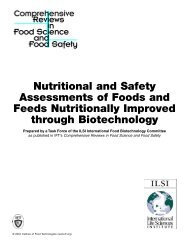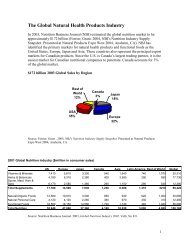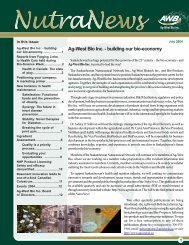Beyond Borders: Global biotechnology report 2010
Beyond Borders: Global biotechnology report 2010
Beyond Borders: Global biotechnology report 2010
Create successful ePaper yourself
Turn your PDF publications into a flip-book with our unique Google optimized e-Paper software.
drug application for Lurasidone to the FDA<br />
in <strong>2010</strong>. It also gets Sepracor’s marketed<br />
products, including insomnia drug Lunesta<br />
and the asthma treatment Xopenex, as well<br />
as Stedesa, an epilepsy treatment awaiting<br />
marketing approval.<br />
Takeda Pharmaceuticals, which made a<br />
splash a couple of years earlier with its<br />
US$8.8 billion acquisition of Millennium<br />
Pharmaceuticals, acquired another<br />
US-based company in May 2009, albeit<br />
for a much smaller purchase price. The<br />
company acquired California-based IDM<br />
Pharma for US$54.3 million. The deal<br />
allows Takeda to expand its oncology<br />
franchise through the acquisition of<br />
MEPACT, IDM Pharma’s treatment for<br />
non-metastatic osteosarcoma.<br />
In August, Hisamitsu Pharmaceutical<br />
acquired Miami-based Noven<br />
Pharmaceuticals for US$428 million.<br />
The US$16.50-per-share purchase price<br />
represents a 43% premium relative to<br />
Noven’s average closing price for 90 days<br />
preceding the announcement. Once again,<br />
a key driver for the Japanese acquirer was<br />
establishing a US presence. In addition,<br />
Hisamitsu gained Noven’s capabilities in<br />
transdermal drug development and intends<br />
to incorporate Noven’s technologies into its<br />
drug development efforts.<br />
Outlook<br />
The worst of the global financial crisis<br />
appears to be over, but funding in the “new<br />
normal” remains challenging for many<br />
biotech companies across the world. In<br />
Japan, where venture capital for emerging<br />
companies was scarce even before the<br />
crisis, the funding challenge is truly stark.<br />
The Japanese Government continues to<br />
make the biotech industry a major priority,<br />
and efforts such as the INCJ could help,<br />
provided a significant enough portion of<br />
the funding goes to high-potential biotech<br />
42 <strong>Beyond</strong> borders <strong>Global</strong> <strong>biotechnology</strong> <strong>report</strong> <strong>2010</strong><br />
companies. But Japan’s biotech challenges<br />
run deeper, and it is not simply a matter<br />
of throwing money at the problem. In<br />
that regard, it is encouraging that the<br />
INCJ includes a vetting process and<br />
experienced leadership to increase the<br />
likelihood of funding truly innovative ideas<br />
with commercial potential. To make sure<br />
that Japanese innovations make the long<br />
journey to commercialization, efforts will<br />
need to be made to ensure that there is<br />
sufficient funding at every stage. With those<br />
changes, Japan might finally build a biotech<br />
industry that reflects its long tradition of<br />
technological and business leadership.








